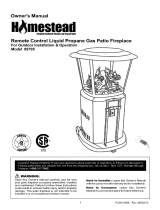
www.fmiproducts.com
125343-01C2
SAFETY
WARNING: Improper instal-
lation, adjustment, alteration,
service or maintenance can
cause injury or property damage.
Read the installation, operating
and maintenance instructions
thoroughly before installing or
servicing this equipment.
WARNING: This product con-
tains and/or generates chemicals
known to the state of California
to cause cancer or birth defects
or other reproductive harm.
IMPORTANT: Read this owner’s
manual carefully and completely
before trying to assemble, op-
erate or service this replace.
Improper use of this replace
can cause serious injury or
death from burns, re, explo-
sion, electrical shock and carbon
monoxide poisoning.
DANGER: Carbon monoxide
poisoning may lead to death!
Carbon Monoxide Poisoning: Early signs
of carbon monoxide poisoning resemble the
u, with headaches, dizziness or nausea. If
you have these signs, the heater may not
be working properly. Get fresh air at once!
Have heater serviced. Some people are
more affected by carbon monoxide than oth-
ers. These include pregnant women, people
with heart or lung disease or anemia, those
under the inuence of alcohol and those at
high altitudes.
Natural and Propane/LP Gas: Natural and
propane/LP gases are odorless. An odor-
making agent is added to the gas. The odor
helps you detect a gas leak. However, the
odor added to the gas can fade. Gas may be
present even though no odor exists.
Make certain you read and understand all
warnings. Keep this manual for reference. It
is your guide to safe and proper operation of
this replace.
WARNING: Any change to
this heater or its controls can
be dangerous.
Due to high temperatures, the
appliance should be located out
of trafc and away from furniture
and draperies.
Do not place clothing or other
ammable material on or near
the appliance. Never place any
objects on the replace.
Fireplace front and screen be-
come very hot when running re-
place. Keep children and adults
away from hot surfaces to avoid
burns or clothing ignition. Fire-
place will remain hot for a time
after shutdown. Allow surfaces
to cool before touching.
Carefully supervise young chil-
dren when they are in the area
of the replace. When using the
hand-held remote accessory,
keep selector switch in the OFF
position to prevent children from
turning on burners with remote.
TABLE OF CONTENTS
Safety .................................................................. 2
Local Codes......................................................... 3
Product Features ................................................. 4
Locating Fireplace ............................................... 4
Product Specications ......................................... 4
Installation ........................................................... 5
Operation ........................................................... 12
Inspecting Burners............................................. 13
Cleaning and Maintenance ................................ 14
Specications .................................................... 15
Wiring Diagram .................................................. 15
Replacement Parts ............................................ 16
Service Hints ..................................................... 16
Technical Service............................................... 16
Accessories ....................................................... 16
Troubleshooting ................................................. 17
Parts .................................................................. 20
Warranty ..............................................Back Cover

























